Effect of Composted Organic Waste on Miscanthus sinensis Andersson Yield, Morphological Characteristics and Chlorophyll Fluorescence and Content
Abstract
1. Introduction
2. Materials and Methods
2.1. Experiment Description
- Factor 1—treatment in the form of composted municipal waste (MWC) and composted mushroom substrate (MSC) applied in different combinations, each with the same N dose of 170 kg N ha−1. For example, by applying the combined dose of MWC75% with MSC25% (number 3 below), 75% of N was provided by municipal waste compost, and 25% was provided by mushroom substrate compost. Organic fertilizers were applied according to this scheme:
- Control plot (no treatment);
- MWC100% (3.49 kg per plot; 17.450 Mg·ha−1);
- MWC75% (2.62 kg per plot; 13.100 Mg·ha−1) + MSC25% (1.40 kg per plot; 7 Mg·ha−1);
- MWC50% (1.74 kg per plot; 8.700 Mg·ha−1) + MSC50% (2.80 kg per plot; 14 Mg·ha−1);
- MWC25% (0.87 kg per plot; 4.350 Mg·ha−1) + MSC75% (4.20 kg per plot; 21 Mg·ha−1);
- MSC100% (5.60 kg per plot; 28 Mg·ha−1).
- Factor 2—experimental years 2018, 2019, and 2020.
2.2. Determination of Soil and Organic Material Properties
- PH value in H2O and in 1 mol/L KCl by the potentiometric method;
- Total hydrolytic acidity and the sum of basic cations (S) by the Kappen method, on the basis of which soil sorption capacity (T) and base saturation were calculated;
- Total C, N and H content by elemental analysis (using the PerkinElmer (U. S. Instrument Division, Norwalk, CT 06859 USA) 2400 Series II CHNS/O Elemental Analyzer with thermal conductivity detector) and the total (in the calculations assumed as total, but in reality, similar to it) content of Ni, Cu, Cr, Zn, Pb, Cd, K and P by the optical emission spectrometry method after wet mineralization of soil samples using aqua regia, at Eurofins OBiKŚ Polska Ltd. in Katowice, Poland, the former Centre for Environmental Research and Control.
- Dry matter content by drying the sample at 105 °C to obtain a constant weight;
- PH in H2O and in 1 mol/L KCl by potentiometric method;
- Total N content (Nt) by the modified Kjeldahl method after mineralisation of samples with concentrated sulphuric acid in the presence of a selenium mixture [28];
- Organic C (Corg) by the oxidation–titration method [29];
- Total content of macroelements (P and K) and heavy metals (Co, Pb, Cd, Cr, Zn and Ni) by inductively coupled plasma atomic emission spectrometry (ICP-OES) after soil sample mineralization with aqua regia.
2.3. Determination of Biomass Properties
- −
- Minimum fluorescence (Fo);
- −
- Maximum fluorescence (Fm).
- −
- Number of nodes per stem;
- −
- Diameter of the stem;
- −
- Number of leaf blades per stem;
- −
- Length of leaf blades;
- −
- Width of leaf blades;
- −
- Number of all stems;
- −
- Length of the stem.
2.4. Weather Conditions
2.5. Statistical Analysis
3. Results
4. Conclusions
Author Contributions
Funding
Data Availability Statement
Conflicts of Interest
References
- Chia, W.Y.; Chew, K.W.; Le, C.F.; Lam, S.S.; Chee, C.S.C.; Ooi, M.S.L.; Show, P.L. Sustainable utilization of biowaste compost for renewable energy and soil amendments. Environ. Pollut. 2020, 267, 115662. [Google Scholar] [CrossRef] [PubMed]
- Gralak, A. Implementing a circular economic model in the bioeconomy. Probl. World Agric. 2021, 21, 24–40. [Google Scholar]
- Santamarta, J.C.; Miklin, L.; Gomes-Nadal, C.O.; Rodríguez-Alcántara, J.S.; Rodríguez-Martín, J.; Cruz-Pérez, N. Waste Management and Territorial Impact in the Canary Islands. Land 2023, 12, 212. [Google Scholar] [CrossRef]
- Leogrande, R.; Vitti, C.; Castellini, M.; Garofalo, P.; Samarelli, I.; Lacolla, G.; Montesano, F.F.; Spagnuolo, M.; Mastrangelo, M.; Stellacci, A.M. Residual Effect of Compost and Biochar Amendment on Soil Chemical, Biological, and Physical Properties and Durum Wheat Response. Agronomy 2024, 14, 749. [Google Scholar] [CrossRef]
- Altobelli, F.; Vargas, R.; Corti, G.; Dazzi, C.; Montanarella, L.; Monteleone, A.; Caon, L.; Piazza, M.G.; Calzolari, C.; Munafò, M.; et al. Improving soil and water conservation and ecosystem services by sustainable soil management practices: From a global to an Italian soil partnership. Ital. J. Agron. 2020, 15, 293–298. [Google Scholar] [CrossRef]
- Qaseem, M.F.; Wu, A.-M. Marginal lands for bioenergy in China; an outlook in status, potential and management. GCB Bioenergy 2021, 13, 21–44. [Google Scholar] [CrossRef]
- Stewart, J.R.; Toma, Y.; Fernández, F.G.; Nishiwaki, A.; Yamada, T.; Bollero, G. The ecology and agronomy of Miscanthus sinensis, a species important to bioenergy crop development, in its native range in Japan: A review. GCB Bioenergy 2009, 1, 126–153. [Google Scholar] [CrossRef]
- Ning, P.; Yang, G.; Hu, L.; Sun, J.; Shi, L.; Zhou, Y.; Wang, Z.; Yang, J. Recent advances in the valorization of plant biomass. Biotechnol. Biofuels 2021, 14, 102. [Google Scholar] [CrossRef]
- Jańczak-Pieniążek, M.; Pikuła, W.; Pawlak, R.; Drygaś, B.; Szpunar-Krok, E. Physiological Response of Miscanthus sinensis (Anderss.) to Biostimulants. Agriculture 2024, 14, 33. [Google Scholar] [CrossRef]
- Wang, C.; Kong, Y.; Hu, R.; Zhou, G. Miscanthus: A fast-growing crop for environmental remediation and biofuel production. GCB Bioenergy 2020, 13, 58–69. [Google Scholar] [CrossRef]
- Panoutsou, C.; Chiaramonti, D. Socio-economic opportunities from Miscanthus cultivation in marginal land for bioenergy. Energies 2020, 13, 2741. [Google Scholar] [CrossRef]
- Zheng, C.; Iqbal, Y.; Labonte, N.; Sun, G.; Feng, H.; Yi, Z.; Xiao, L. Performance of switchgrass and Miscanthus genotypes on marginal land in the Yellow River Delta. Ind. Crops Prod. 2019, 141, 111773. [Google Scholar] [CrossRef]
- von Cossel, M.; Mangold, A.; Iqbal, Y.; Hartung, J.; Lewandowski, I.; Kiesel, A. How to Generate Yield in the First Year—A Three-Year Experiment on Miscanthus (Miscanthus × giganteus (Greef et Deuter)) Establishment under Maize (Zea mays L.). Agronomy 2019, 9, 237. [Google Scholar] [CrossRef]
- Salis, L.; Cabiddu, A.; Sanna, F.; Sitzia, M.; Carboni, G. Municipal solid waste compost use can improve crop barley production and enhance soil chemical fertility. Eur. J. Agron. 2024, 153, 127064. [Google Scholar] [CrossRef]
- Susic, M. Replenishing humic acids in agricultural soils. Agronomy 2016, 6, 45. [Google Scholar] [CrossRef]
- Shaji, H.; Chandran, V.; Mathew, L. Organic fertilizers as a route to controlled release of nutrients. In Controlled Release Fertilizers for Sustainable Agriculture; Academic Press: Cambridge, MA, USA, 2021; pp. 231–245. [Google Scholar]
- Maucieri, C.; Barco, A.; Borin, M. Compost as a substitute for mineral N fertilization? Effects on crops, soil and N leaching. Agronomy 2019, 9, 193. [Google Scholar] [CrossRef]
- Erhart, E.; Hartl, W.; Putz, B. Biowaste compost affects yield, nitrogen supply during the vegetation period and crop quality of agricultural crops. Eur. J. Agron. 2005, 23, 305–314. [Google Scholar] [CrossRef]
- Debicka, M.; Jamroz, E.; Bekier, J.; Ćwieląg-Piasecka, I.; Kocowicz, A. The Influence of Municipal Solid Waste Compost on the Tranformations of Phosphorus Forms in Soil. Agronomy 2023, 13, 1234. [Google Scholar] [CrossRef]
- Bagagiolo, G.; Vigoroso, L.; Pampuro, N.; Cavallo, E. The Role of Social Interaction and Personal Characteristics in Affecting the Adoption of Compost from Organic Fraction of Municipal Solid Waste in Italy. Agronomy 2022, 12, 445. [Google Scholar] [CrossRef]
- Poudel, P.; Duenas, A.E.; Di Gioia, F. Orgaic waste compost and spent mushroom compost as potential growing media components for the sustainable production of microgreens. Front. Plant Sci. 2023, 14, 1229157. [Google Scholar] [CrossRef]
- Singh, C.; Pathak, P.; Chaudhary, N.; Rathi, A.; Dehariya, P.; Vyas, D. Mushrooms and mushroom composts in integrated farm management. Res. J. Agric. Sci. 2020, 11, 1436–1443. [Google Scholar]
- Liu, N.; Yu, R.; Deng, W.; Hu, R.; He, G.; He, K.; Kong, Y.; Tang, X.; Zhou, G.; Wang, C. MsHDZ23, a Novel Miscanthus HD-ZIP Transcription Factor, Participates in Tolerance to Multiple Abiotic Stresses. Int. J. Mol. Sci. 2024, 25, 3253. [Google Scholar] [CrossRef] [PubMed]
- Polish Standard PN-R-04033; Soils and Mineral Formations—Divisi on into Fractions and Granulometric Groups. Polish Committee for Standardization (PKN): Warszawa, Poland, 1998.
- Soil Science Society. Grading classification of soils and mineral formations. Roczn. Glebozn. 2009, 60, 5–16. [Google Scholar]
- Regulation of the Minister of the Environment of 1 September 2016 on the Method of Conducting the Assessment of Soil Contamination Dz. U.2016, poz. 1395). Available online: https://isap.sejm.gov.pl/isap.nsf/DocDetails.xsp?id=wdu20160001395 (accessed on 12 April 2024).
- Regulation of the Minister of Agriculture and Rural Development of 18 June 2008 on the Implementation of Certain Provisions of the Act on Fertilizers and Fertilization (Dz. U. 2008, poz. 119, 765). Available online: https://isap.sejm.gov.pl/isap.nsf/DocDetails.xsp?id=WDU20081190765 (accessed on 13 April 2024).
- Kalembasa, S.; Carlson, R.W.; Kalembasa, D. A new method for the reduction in nitrates in total N determination accordingto the Kjeldahl method. Pol. J. Soil Sci. 1989, 22, 21–26. [Google Scholar]
- Kalembasa, S.; Kalembasa, D. A quick method for determination of C/N ratio in mineral soils. Pol. J. Soil Sci. 1992, 25, 41–46. [Google Scholar]
- Skowera, B.; Puła, J. Pluviometric extreme conditions in spring season in Poland in the years 1971–2000. Acta Agroph. 2004, 1, 171–177. (In Polish) [Google Scholar]
- Statistica (Data Analysis Software System), Version 13.1; StatSoft, Inc.: Tulsa, OK, USA, 2021. Available online: www.statsoft.com (accessed on 25 May 2023).
- Vitti, A.; Elshafie, H.S.; Logozzo, G.; Marzario, S.; Scopa, A.; Camele, I.; Nuzzaci, M. Physicochemical characterization and biological activities of a digestate and a more stabilized digestate-derived compost from agro-waste. Plants 2021, 10, 386. [Google Scholar] [CrossRef] [PubMed]
- Madej, M.; Mamelka, D. Heavy metals in waste from green areas of Warsaw in terms of their suitability for composting. Issue Pap. Prog. Agric. Sci. 2004, 501, 275–281. (In Polish) [Google Scholar]
- Polish Standard BN-89/9103-09; Municipal waste management.
- Mladenov, M. Chemical composition of different types of compost. J. Chem. Technol. Metall. 2018, 53, 712–716. [Google Scholar]
- Filipek-Mazur, B.; Gondek, K. The fertilizing value of compost from Krakow’s green waste. Zesz. Probl. Postępów Nauk. Rol. 2003, 494, 113–122. (In Polish) [Google Scholar]
- Gubišová, M.; Gubiš, J.; Žofajová, A. Biomass production of gigantic grasses Arundo donax and Miscanthus × giganteus in the dependence on plant multiplication method. Agriculture 2016, 62, 43–51. [Google Scholar] [CrossRef]
- Clifton-Brown, J.C.; Lewandowski, I.; Andersson, B.; Basch, G.; Christian, D.G.; Kjeldsen, J.B.; J⊘Rgensen, U.; Mortensen, J.V.; Riche, A.B.; Schwarz, K.-U.; et al. Performance of 15 Miscanthus genotypes at five sites in Europe. Agron. J. 2001, 93, 1013–1019. [Google Scholar] [CrossRef]
- Dradrach, A.; Gąbka, D.; Szlachta, J.; Wolski, K. Energy value of several grass species cultivated on light soils. Łąkarstwo Polsce (Grassl. Sci. Pol.) 2007, 10, 29–35. (In Polish) [Google Scholar]
- Lim, S.-H.; Yook, M.-J.; Song, J.-S.; Kim, J.-W.; Zhang, C.-J.; Kim, D.-G.; Park, Y.-H.; Lee, D.; Kim, D.-S. Diversity in Phenological and Agronomic Traits of Miscanthus sinensis Collected in Korea and Eastern Asia. Agronomy 2021, 11, 900. [Google Scholar] [CrossRef]
- Scordia, D.; Scalici, G.; Clifton-Brown, J.; Robson, P.; Patanè, C.; Cosentino, S.L. Wild Miscanthus Germplasm in a Drought-Affected Area: Physiology and Agronomy Appraisals. Agronomy 2020, 10, 679. [Google Scholar] [CrossRef]
- Malinowska, M.; Donnison, I.; Robson, P. Morphological and physiological features explaining the response of crops to drought stress in Miscanthus. Agronomia 2020, 10, 1194. [Google Scholar] [CrossRef]
- Robson, P.; Jensen, E.; Hawkins, S.; White, S.R.; Kenobi, K.; Clifton-Brown, J.; Donnison, I.; Farrar, K. Accelerating the domestication of a bioenergy crop: Identifying and modelling morphological targets for sustainable yield increase in Miscanthus. J. Exp. Bot. 2013, 64, 4143–4155. [Google Scholar] [CrossRef] [PubMed]
- Weng, T.-Y.; Nakashima, T.; Villanueva-Morales, A.; Stewart, J.R.; Sacks, E.J.; Yamada, T. Assessment of Drought Tolerance of Miscanthus Genotypes through Dry-Down Treatment and Fixed-Soil-Moisture-Content Techniques. Agriculture 2022, 12, 6. [Google Scholar] [CrossRef]
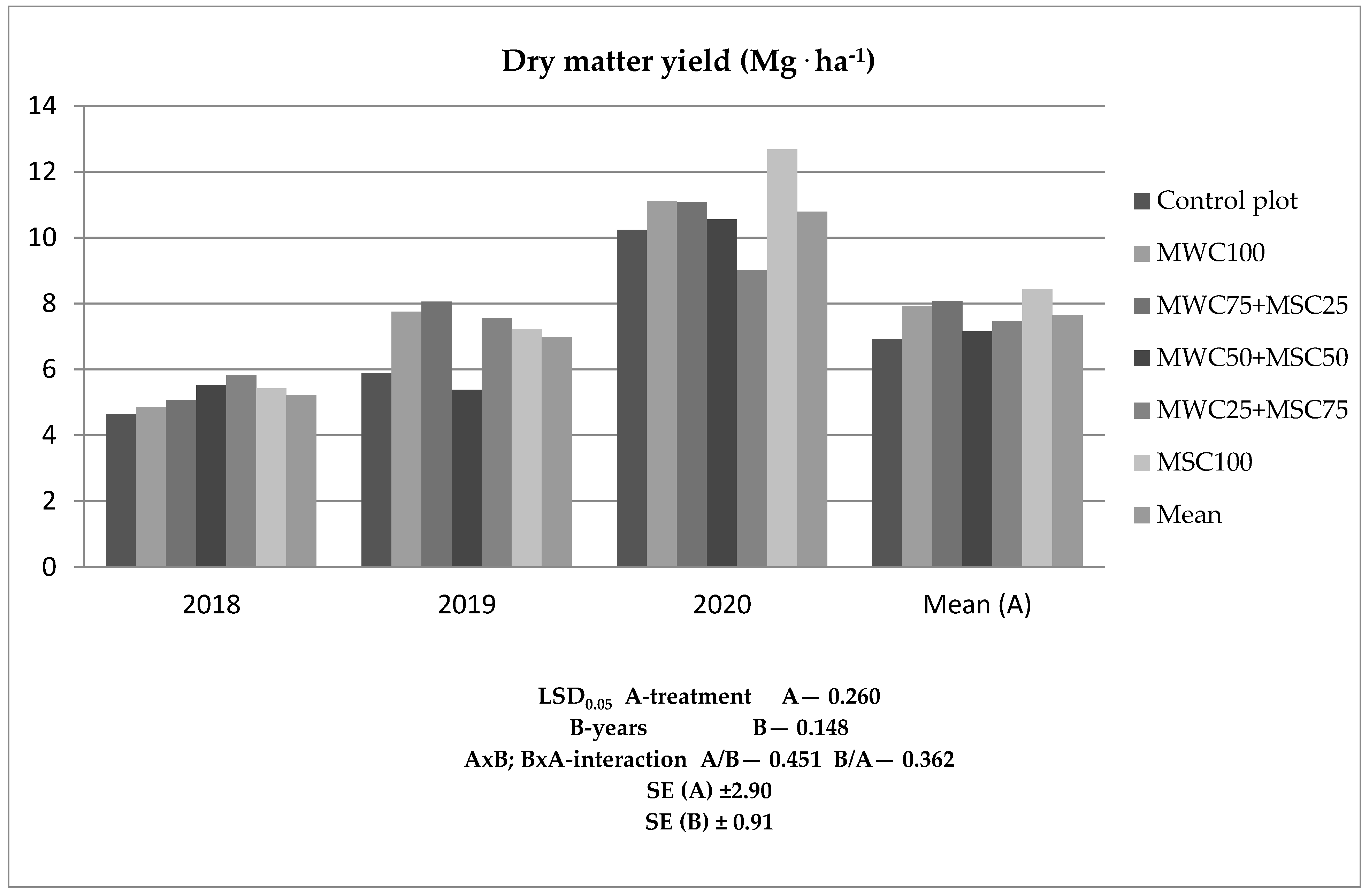
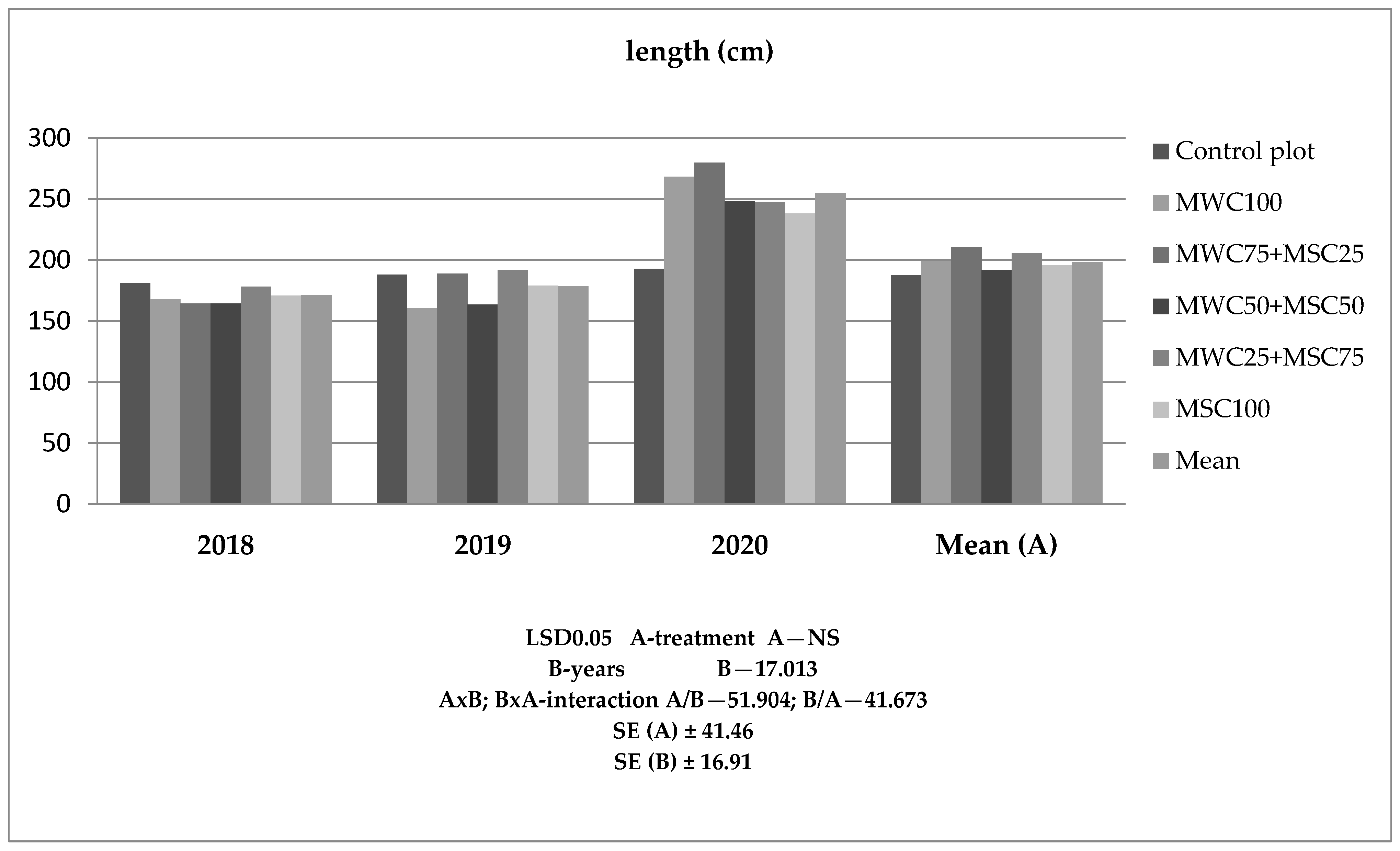

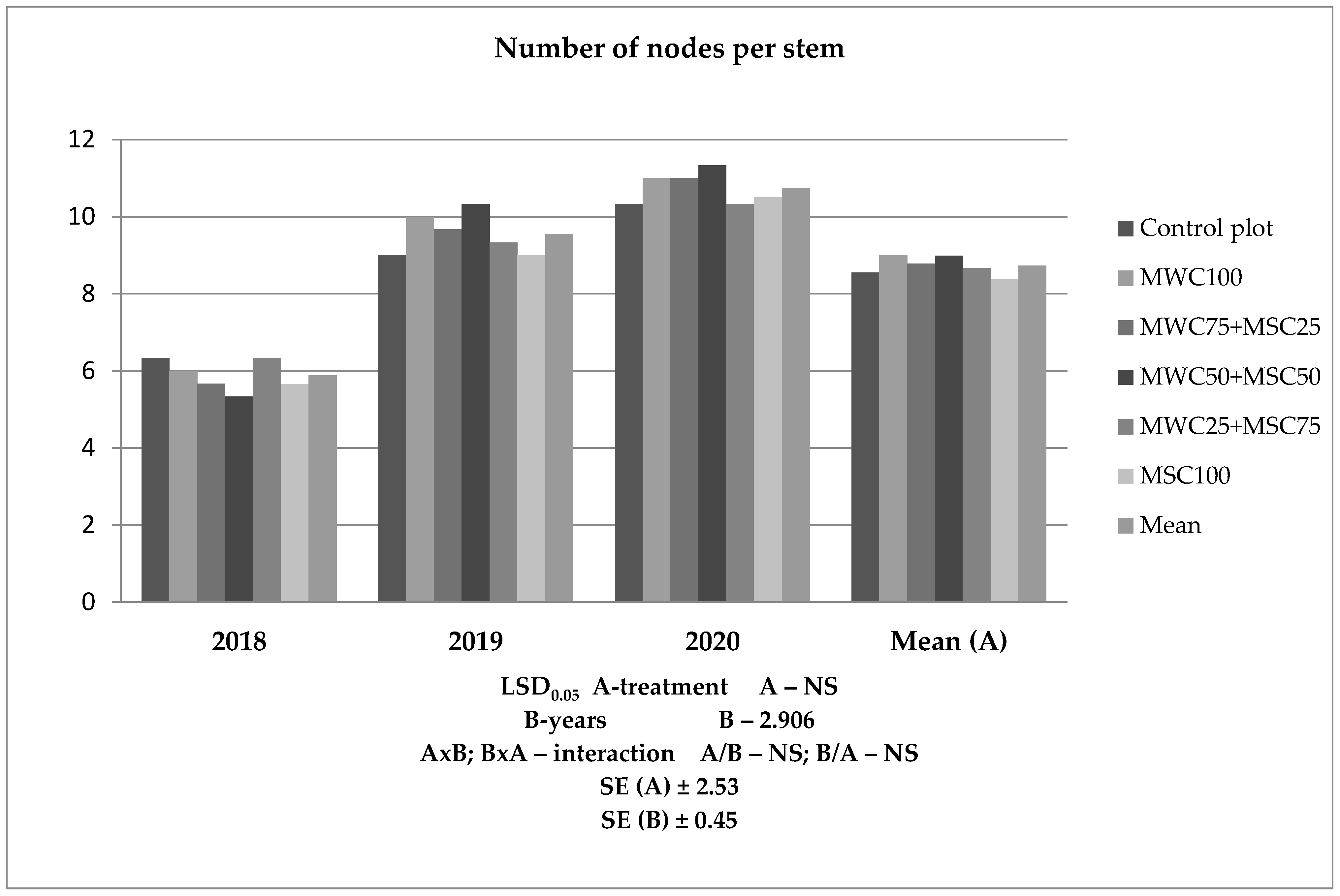

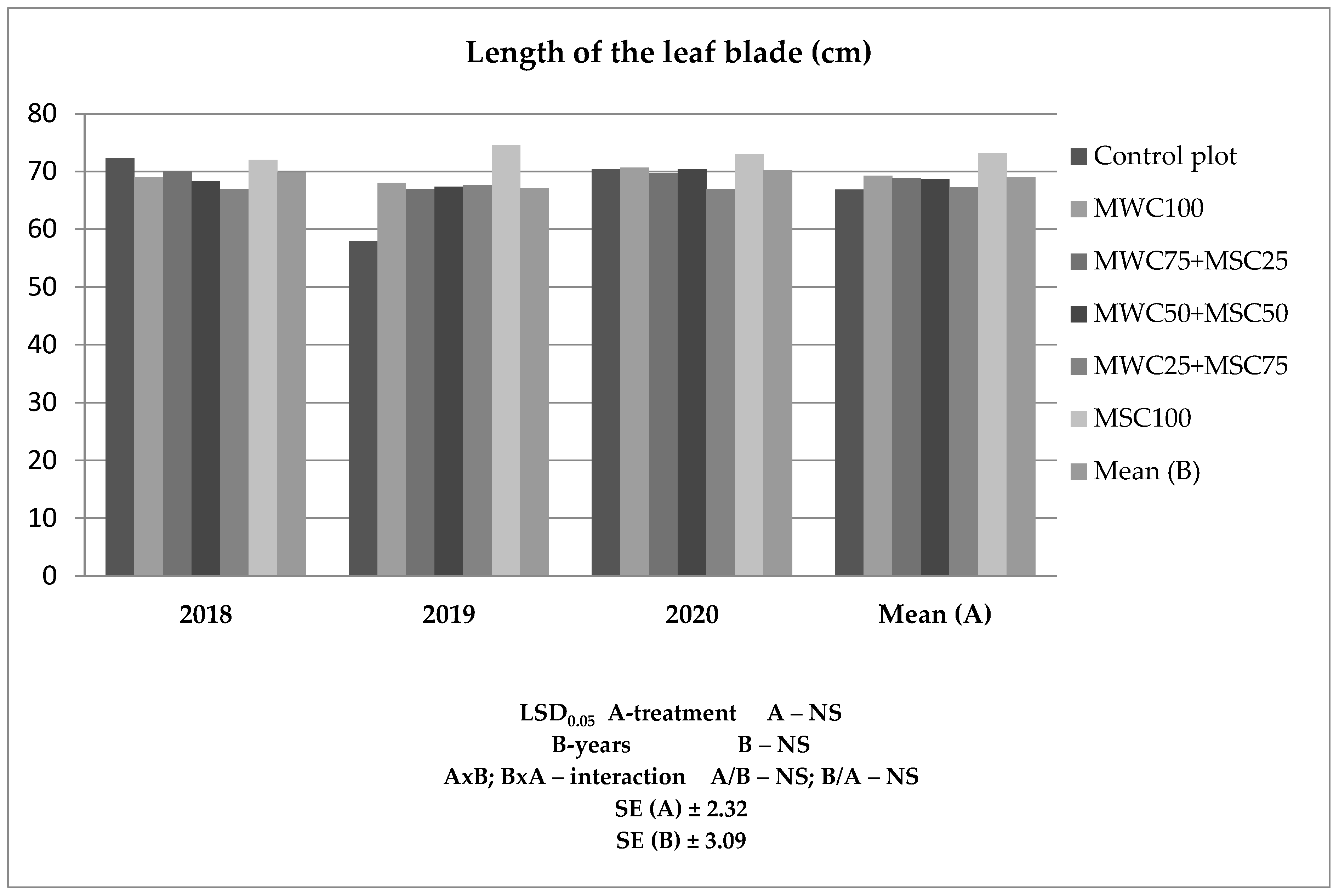
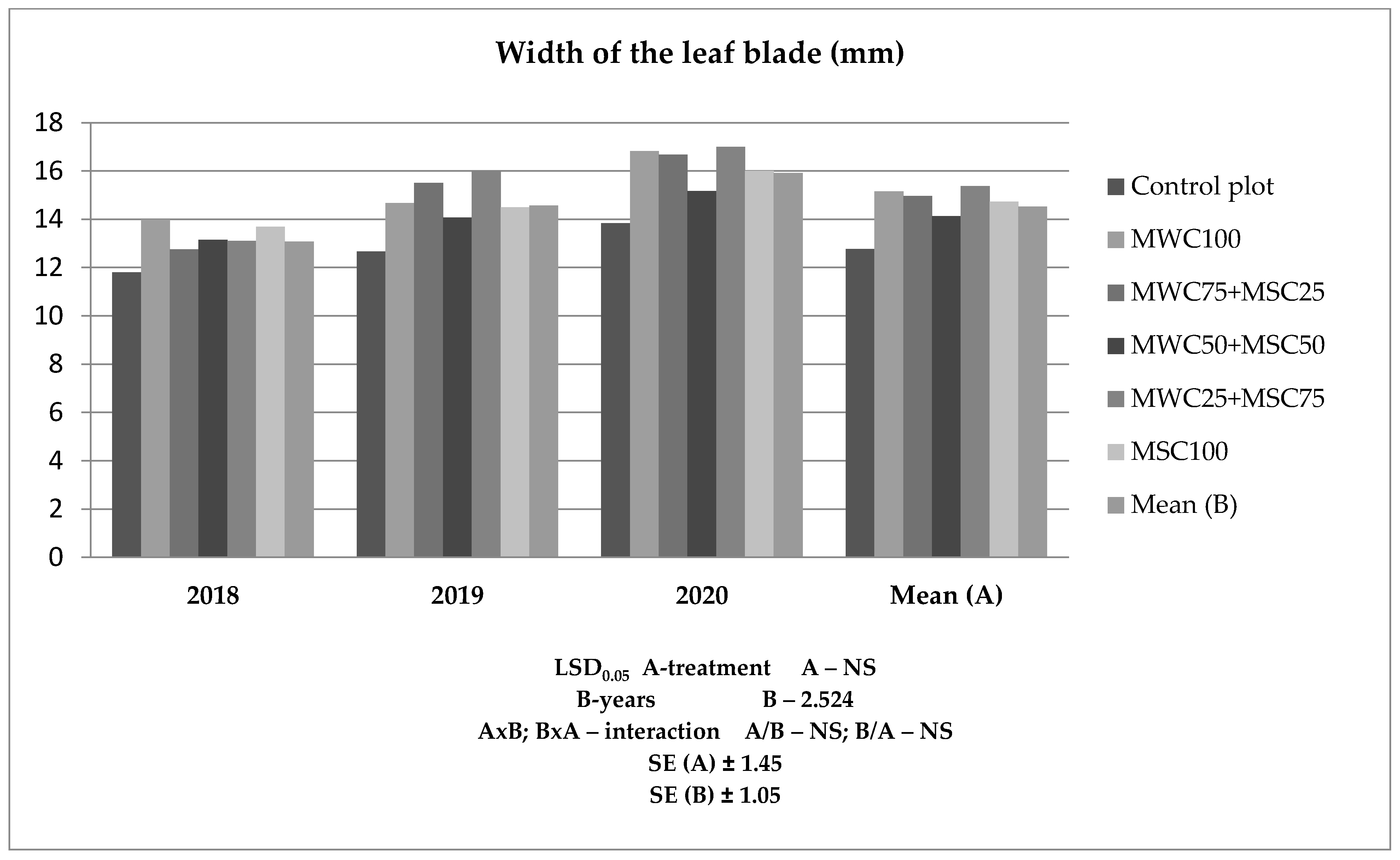
| Year | Month | ||||||
|---|---|---|---|---|---|---|---|
| April | May | June | July | August | September | October | |
| 2018 | 1.07 fd | 0.50 vd | 1.38 o | 1.58 o | 0.44 vd | 0.92 d | 1.52 o |
| 2019 | 0.32 ed | 2.83 vw | 0.44 vd | 0.72 d | 1.21 fd | 1.01 fd | 0.62 vd |
| 2020 | 0.29 ed | 3.24 ew | 3.02 ew | 0.69 vd | 1.09 fd | 1.06 fd | 2.73 vw |
| Organic Fertiliser | pH | DM (%) | Corg | C:N | N | P | K |
|---|---|---|---|---|---|---|---|
| g.kg−1 DM | g.kg−1 DM | ||||||
| MWC | 7.10 | 68 | 236 | 14.93 | 14.30 | 17.32 | 25.4 |
| MSC | 6.4 | 30.00 | 284 | 13.59 | 20.9 | 8.86 | 11.21 |
| Organic Fertiliser | Co | Pb | Cd | Cr | Zn | Ni |
|---|---|---|---|---|---|---|
| mg·kg−1 DM | ||||||
| MWC | 3.58 | 78.4 | 2.08 | 34.12 | 623.2 | 15.6 |
| MSC | 0.415 | 3.98 | 0.287 | 3.08 | 156.9 | 4.84 |
| Treatment (A) | Years (B) | Mean | ||
|---|---|---|---|---|
| 2018 | 2019 | 2020 | ||
| Control plot | 295 | 174 | 254 | 241 |
| MWC100 | 272 | 217 | 221 | 236 |
| MWC75 + MSC25 | 217 | 209 | 178 | 201 |
| MWC50 + MSC50 | 284 | 235 | 240 | 253 |
| MWC25 + MSC75 | 237 | 182 | 211 | 210 |
| MSC100 | 232 | 267 | 254 | 251 |
| Mean | 256 | 214 | 226 | 232 |
| Treatment (A) | Years (B) | Mean | ||
|---|---|---|---|---|
| 2018 | 2019 | 2020 | ||
| Control plot | 592 | 502 | 677 | 590 |
| MWC100 | 568 | 563 | 607 | 579 |
| MWC75 + MSC25 | 565 | 519 | 496 | 526 |
| MWC50 + MSC50 | 607 | 788 | 508 | 634 |
| MWC25 + MSC75 | 526 | 577 | 573 | 558 |
| MSC100 | 369 | 637 | 717 | 574 |
| Mean | 538 | 598 | 596 | 577 |
| Treatment (A) | Years (B) | Mean | ||
|---|---|---|---|---|
| 2018 | 2019 | 2020 | ||
| Control plot | 38.77 | 30.80 | 38.53 | 36.03 |
| MWC100 | 31.27 | 31.53 | 38.50 | 33.77 |
| MWC75 + MSC25 | 38.07 | 28.27 | 40.07 | 35.47 |
| MWC50 + MSC50 | 34.90 | 29.97 | 40.83 | 35.23 |
| MWC25 + MSC75 | 35.67 | 30.37 | 40.33 | 34.46 |
| MSC100 | 34.43 | 28.23 | 36.87 | 33.18 |
| Mean | 35.52 | 29.86 | 39.19 | 34.86 |
Disclaimer/Publisher’s Note: The statements, opinions and data contained in all publications are solely those of the individual author(s) and contributor(s) and not of MDPI and/or the editor(s). MDPI and/or the editor(s) disclaim responsibility for any injury to people or property resulting from any ideas, methods, instructions or products referred to in the content. |
© 2024 by the authors. Licensee MDPI, Basel, Switzerland. This article is an open access article distributed under the terms and conditions of the Creative Commons Attribution (CC BY) license (https://creativecommons.org/licenses/by/4.0/).
Share and Cite
Zając, M.; Skrajna, T. Effect of Composted Organic Waste on Miscanthus sinensis Andersson Yield, Morphological Characteristics and Chlorophyll Fluorescence and Content. Agronomy 2024, 14, 1672. https://doi.org/10.3390/agronomy14081672
Zając M, Skrajna T. Effect of Composted Organic Waste on Miscanthus sinensis Andersson Yield, Morphological Characteristics and Chlorophyll Fluorescence and Content. Agronomy. 2024; 14(8):1672. https://doi.org/10.3390/agronomy14081672
Chicago/Turabian StyleZając, Mariola, and Teresa Skrajna. 2024. "Effect of Composted Organic Waste on Miscanthus sinensis Andersson Yield, Morphological Characteristics and Chlorophyll Fluorescence and Content" Agronomy 14, no. 8: 1672. https://doi.org/10.3390/agronomy14081672
APA StyleZając, M., & Skrajna, T. (2024). Effect of Composted Organic Waste on Miscanthus sinensis Andersson Yield, Morphological Characteristics and Chlorophyll Fluorescence and Content. Agronomy, 14(8), 1672. https://doi.org/10.3390/agronomy14081672






